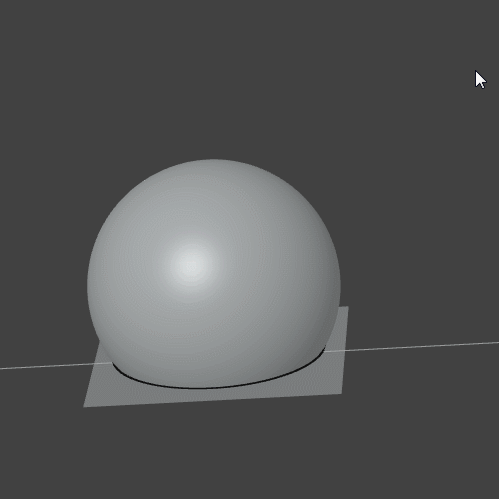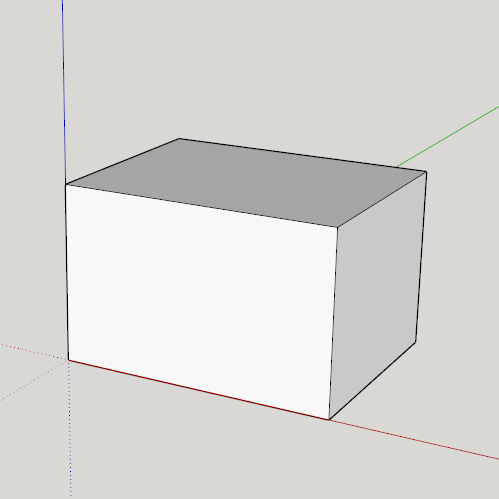I am able to create a sphere with a flat on the bottom and I can create a hole in the remaining ball. Next I create a circle on the surface of the flat area pushing it into the sphere for a 0.750 hole. When I export this as a .stl file, I receive an error with the message indicating the area on the interior of the drilled hole is not part of the model. I am not sure what I have missed in creating the part. It looks correct in Sketchup.
Sphere with 0.75 hole and print lip.skp (225.6 KB)
Firstly you need to reverse the main face as the blue gray is the back face.
Then you need to push the hole to a depth or all the way through so it is a tube not a hole.

The hole that you are modifying in the reply should not even be there. It was an added artifact added when I drilled from the bottom. That is where the flat and the 3/4" drill hole should be. This current view is looking from the top where the issues are showing up.
I first created the sphere using the follow me tool. I then took the circle I used to follow and moved it down to the position I wanted to delete the bottom portion of the sphere. this would leave me a flat for drilling.
Next I placed a circle on the surface of the flat and used the push/pull tool to drill the cylinder into the sphere. That is where I run into trouble and where the model goes askew. It leaves the hole at the top even though the cylinder is not pushed up to the edge of the sphere. It is like the cylinder has no bottom thus it is not apart of the solid.
I keep trying different things with grouping and exploding and interfacing the parts with out luck. I know that I am missing a major concept somewhere. This product should not be this hard to construct solids.
You’re running into SketchUp’s tiny face/short edge limitations. The edges making up the rim of the hole are extremely short. shorter than SketchUp is designed to work with.
If you are modeling for 3D printing you could either work at a larger scale or use the Dave Method to create the tiny geometry. Since .stl files are unitless, I leverage that when I’m modeling for 3D printing. I model with SketchUp’s units set to meters and enter inches or millimeters as meters. Then I import the resulting .stl file into the slicer as either inches or millimeters as needed. No need to scale the model down before exporting the .stl file.
Is the radius of the sphere really supposed to be 1/2 inch or is 0.501212" correct?
Here’s an example.
As modeled:
Ready for printing.
Here I’ve done what I described with your model. After Follow Me the cut off sphere with the hole in the bottom makes a nice, solid component.
Exported the .stl in Meters, uploaded as inches.
Thanks Dave. I was having the same issue when I created the sphere initially and had to make the circle 10" instead of 1". I just have to remember my scale when trying to accurately create a 3/4" hole. What the ultimate goal is a ball that fits on the end of a 3/4" rod. This seemed to be a relatively simple project for learning about Sketchup. I’ll keep trying things. My biggest concern was the inside bottom of the hole. I wanted to make sure that it was a part of the model. Thanks again for help with limitations.
Again, if you set the units to meters and ignore the m, you can simply type in your dimensions as if they are inches. That’s what I did to make my version of your model. This works well for very highly detailed models, too. These shoulder screws have 6mm x 1.0 threads.

The body of this jack is less than 2-1/4 inches tall and the knurling is quite small but because they were modeled as I described, all of the parts are solid components and could be 3D printed.
Everything you’ve been discussing with Dave is absolutely correct and to the point.
Even so, going back to my original reply with the gif, if you had followed what I did you could have stopped before the pushpull and got the result you wanted.
This is you model, face reversed, hole filled by drawing in one segment then exported to stl and opened in my printer software.

Ok. I am working on this to see if I understand the face reversed. That seems to be the place that I am missing. Give me a little time to review this and maybe even reconstruct this simple model. I really appreciate your guidance.
A simple way of thinking about face orientation.
Take a large cube and a small cube, center the small cube within the large cube.
This can be a couple of things, a solid cube within another solid cube or a void within a solid cube. You need to tell the software which it is.
So the faces that are exposed to the air should be white and the faces that are the inside should be blue.
So in this little gif when you look inside and see a white cube, that is a solid within a solid, but when I reverse the inner cubes faces it becomes a void within a solid.








